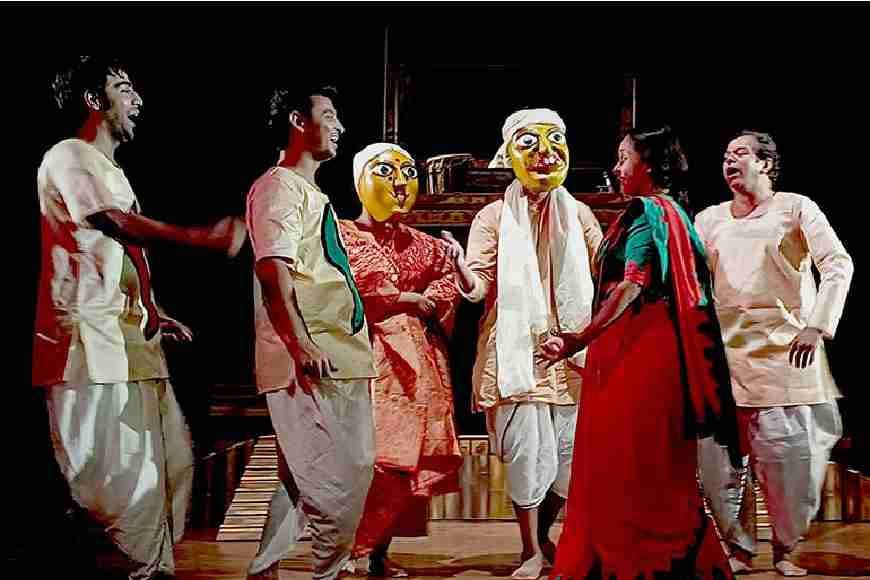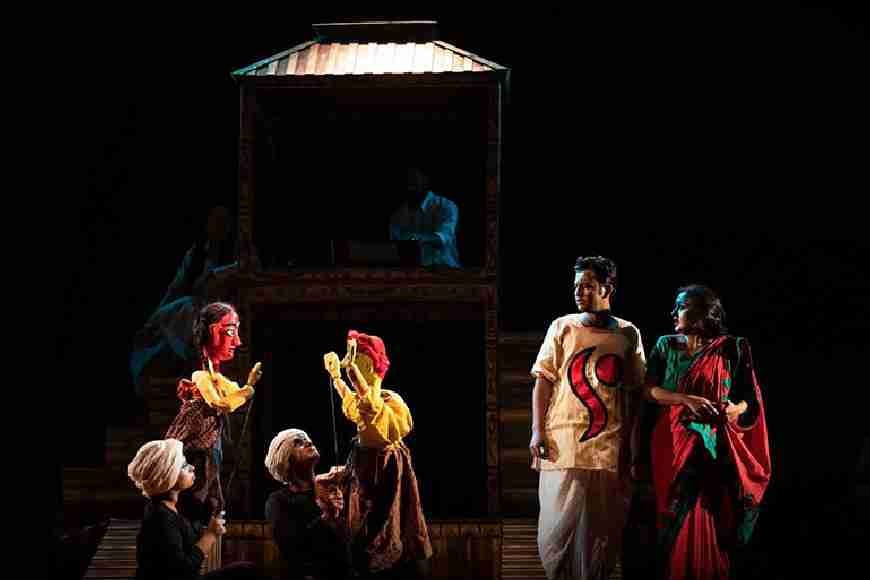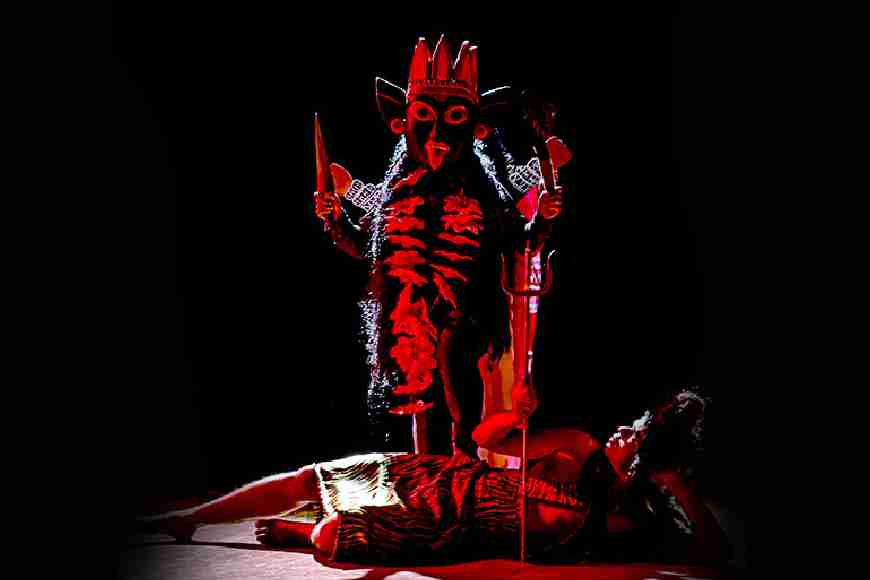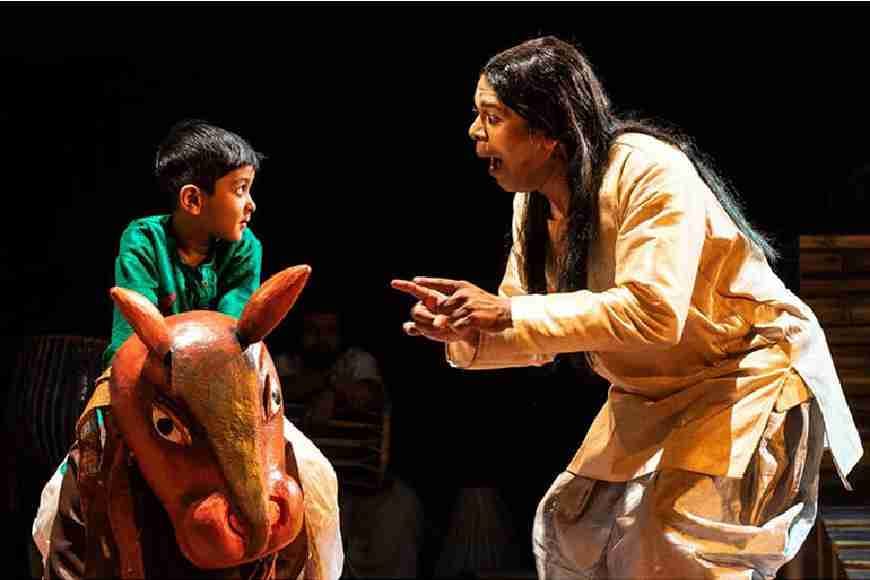Hayavadana: Exploring man’s existential crisis

The essential ambiguity of human personality is shaped or shattered by the human environment. Fundamentally, it is incomplete and imperfect, yet man searches for perfection. It is a natural human instinct to be ‘perfect,’ and this desire drives him to get engaged in a complex psycho-social strife within the self and outside, in search of his identity. Because of this conflict, we are transforming into something else rather than what we were supposed to be. This essential ambiguity of human personality is explored in Sansriti's latest stage production, 'Hayavadana', directed by Debesh Chattopadhyay.

The title of the play, Hayavadana has a significant meaning where, ‘Haya’ means horse/body and ‘vadana’ means man/ head. The play is about a strange horse-faced man, who wants to get rid of this strange life and become a complete human being. The central plot of the play Hayavadana intertwines the sub-plot to investigate the complicated questions of individuality and the temperament. The subplot revolves around the scrambled relationships involving the chief characters, Padmini, Devadatta and Kapila. There is also a surprising complication created by the exchange of bodies and heads of two friends in an abrupt situation. This complexity is the conflict between the mind and the body, which compels man to be at the centre of the question of perfection and imperfection.
The plot of Hayavadana is based on a theme drawn from ‘The Transposed Heads’, a 1940 novella of Thomas Mann, which is originally inspired by a story from the 11th-century ancient collection of tales in Sanskrit, Kathasaritsagara. Based on that novel, Girish Karnad wrote the play 'Hayavadana' in Kannada in 1971, and the play was first staged in the following year i.e., in 1972. Although inspired by Mann’s novella, Karnad takes the play to another level. Karnad’s play takes up the moral problems that are left unresolved in myths, legends and folktales., adding a new level, where a strange incomplete man with a horse-faced wants to be a full man.

In 1972, the year when the play was staged for the first time, revered Professor and poet, Sankha Ghosh translated the drama in Bengali. With this translation, the brilliant play transcended the barrier of language and entered the precinct of Bengali literature. One of the key challenges of literary translation is the need to balance staying faithful to the original work with the need to create something unique and distinctive that will evoke the same feelings and responses as the original. While retaining the true intent of the original text, Dr Ghosh reconstructed 'Hayavadana,' tackling the intricacies of the language sleekly and redeveloped a balanced, comfortable zone with humour and play on words and dialogues oscillating between sombre and comic elements.
According to theatre director, Debesh Chattopadhyay, in the Bengali translation of the play, the choice of words, poetry and style of composition have given a unique dimension to 'Hayavadana'. According to him, ‘Hayavadana' is as much a play by Girish Karnad as it is by Sankha Ghosh.” Chattopadhyay has homogenized the folk elements and while Karnad uses Yakshagana (Yakshagaana is a traditional theatre, developed in Dakshina Kannada, Udupi, Uttara Kannada, Shimoga and western parts of Chikmagalur districts) in the play, Chattopadhyay has used the indigenous South Dinajpur folk dance form of khan in his play. He says, “Just as Sankha Babu infused Bengali flavour in the play with his brilliant use of language and poeticism, I have also tried to imbue the Bengali nuances in the production by introducing elements of Bengali folk drama in the production and designs.”

Translation plays a significant role in filling the gap between different nations and cultures. Literary translations particularly assist different states to reach a universal culture on a mutual ground. In the introduction to the play, Sankha Ghosh writes, “In the first Ganesha-hymn used in my translation, I was surprised to find linguistic similarity with 'Buro Angla' (by Abanindranath Tagore) and I embraced the vocabulary here.” His statement explains how a literary creation in Kannada language merges seamlessly with Bengali literature. And during the stage production of the play, it was pretty much a walkover when the Yakshagana and Mukha dance form used by Karnad in the Kannad play was replaced with the folk dance of Bengal in the Bengali version. Indigenous musical instruments like drums, flutes, dotara, etc. were used for the background score in Chattopadhyay’s production. It is a fascinating tale indeed to trace the journey of the original fable from the Sanskrit ‘Kathasaritsagar’ that inspired German novelist Thomas Mann to write his novella, ‘The Transposed Heads’ and then Karnad took it to another level altogether. In Hayavadana, Karnad sees man at the centre of the universe and his turning point in life is his choice of freedom with which he becomes the maker of himself. He is always in quest for completeness and is always in search of his identity, being away from his world due to his individual alienation. Karnad’s characters appear like lonely figures having a split personality and a divided self because of being victims of existential sufferings and predicaments. Again, poet Sankha Ghosh re-interprets Karnad’s play and theatre director Chattopadhyay’s stage presentation ensures the drama to become one of Bengal's very own theatrical assets.










